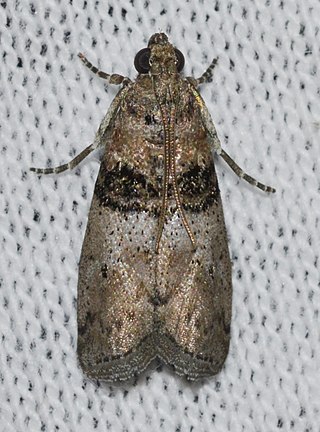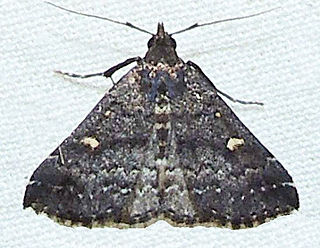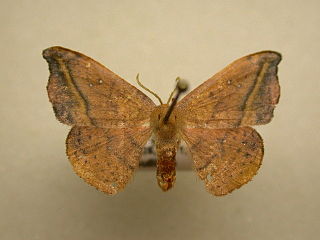
Framinghamia is a genus of moths in the family Crambidae described by Embrik Strand in 1920. It is monotypic, being represented by the single species, Framinghamia helvalis. It was described by Francis Walker in 1859. It is found in North America, where it has been recorded from Alberta to New Brunswick, south to Utah, Texas and Florida. The type locality is Framingham, Massachusetts.
Geshna is a monotypic moth genus of the family Crambidae described by Harrison Gray Dyar Jr. in 1906. It contains only one species, Geshna cannalis, the lesser canna leafroller, described by Altus Lacy Quaintance in 1898. It is found in North America, where it has been recorded from Florida, Mississippi, South Carolina, North Carolina and Tennessee. It has also been recorded from Costa Rica and Cuba.

Macrochilo orciferalis, the chocolate fan-foot or bronzy macrochilo, is a litter moth of the family Erebidae. The species was first described by Francis Walker in 1859. It is found in North America from Wisconsin to Nova Scotia, south to Florida and Texas.

Cydalima perspectalis or the box tree moth is a species of moth of the family Crambidae, first described by Francis Walker, the English entomologist, in 1859. Native to Japan, China, Taiwan, Korea, far-east Russia and India, it has invaded Europe; first recorded in Germany in 2006, then Switzerland and the Netherlands in 2007, Great Britain in 2008, France and Austria in 2009, Hungary in 2011, then Romania, Spain and Turkey. It has been seen in Slovakia, Belgium and Croatia.
Helvibotys helvialis is a moth in the family Crambidae. It was described by Francis Walker in 1859. It is found in North America, where it has been recorded from California to Florida, north in the east to Massachusetts, Quebec, Ontario, Michigan and Iowa.

Nascia acutellus, the streaked orange moth, is a moth in the family Crambidae. It was described by Francis Walker in 1866. It is found in North America, where it has been recorded from Nova Scotia to Florida, west to Texas and north to Nebraska, Michigan and Ontario. It was also reported from Colorado. The habitat consists of wet grassy areas with sedges.

Pyrausta onythesalis is a moth in the family Crambidae. It was described by Francis Walker in 1859. It is found in North America, where it has been recorded from Florida to Georgia, Iowa, Kansas, Oklahoma, Texas and Arizona.
Rhectocraspeda periusalis, the eggplant webworm moth, is a moth in the family Crambidae. It was described by Francis Walker in 1859. It is found in the West Indies and from the United States, where it has been recorded from Florida, North Carolina, Ohio, Oklahoma, South Carolina and Tennessee, south through Mexico and Central America to South America, including Ecuador, Brazil, Guyana, Trinidad and Tobago and Suriname.
Sitochroa dasconalis is a moth in the family Crambidae. It was described by Francis Walker in 1859. It is found in North America, where it has been recorded from Massachusetts to Illinois, south to Florida and then west to Texas.
Rupela tinctella is a moth in the family Crambidae. It was described by Francis Walker in 1863. It is found in Florida, Georgia, Louisiana, Mississippi, North Carolina, South Carolina, Texas, Mexico, Cuba, the Guianas, Trinidad, Brazil (Paraná), Paraguay and northern Argentina.
Bicilia iarchasalis is a species of moth in the family Crambidae. It was described by Francis Walker in 1859. It is found in the south-eastern United States, where it has been recorded from Florida and Texas, as well as in Mexico, Cuba, the Dominican Republic, Puerto Rico and Venezuela.
Diacme mopsalis, the mopsalis diacme moth, is a moth in the family Crambidae. It was described by Francis Walker in 1859. It is found in South America, Central America, the Antilles and the southern United States, where it has been recorded from Arizona, Florida, Oklahoma and Texas.
Diasemiopsis leodocusalis is a moth in the family Crambidae. It was described by Francis Walker in 1859. It is found in North America, where it has been recorded from Alabama, Florida, Georgia, Oklahoma and South Carolina. It has also been recorded from the West Indies to South America.

Tlascala is a monotypic snout moth genus described by George Duryea Hulst in 1890. Its only species is Tlascala reductella, the Tlascala moth, described by Francis Walker in 1863. It is found in North America, where it has been recorded from Florida to Illinois and Kentucky, as well as in Ontario. It has also been recorded from Honduras.

Herpetogramma theseusalis is a moth in the family Crambidae. It was described by Francis Walker in 1859. It is found in North America, where it has been recorded from Alabama, Florida, Maine, Maryland, North Carolina, Quebec, South Carolina, Texas and Virginia.

Hypenula cacuminalis, the long-horned owlet moth, is a moth of the family Erebidae. The species was first described by Francis Walker in 1859. It is found from the south-eastern United States west to Texas and Arizona.
Penestola bufalis, the black penestola moth, is a moth in the family Crambidae. It was described by Achille Guenée in 1854. It is found in the US states of Texas and Florida, as well as on the Antilles. It is an accidentally introduced species on the Galápagos Islands. The habitat consists of coastal mangrove swamps and shorelines.
Salbia tytiusalis is a moth in the family Crambidae. It was described by Francis Walker in 1859. It is found in Florida, the West Indies and Central America, including Honduras.

Oreta rosea, the rose hooktip moth, is a moth in the family Drepanidae. It was described by Francis Walker in 1855. It is found in North America, where it has been recorded across boreal Canada to eastern North America. In the north, the range extends to northern Alberta, northern Manitoba and Newfoundland. It is also found east of the Great Plains as far south as Florida and eastern Texas. The habitat consists of moist temperate hardwood forests.
Noreia ajaia is a moth of the family Geometridae first described by Francis Walker in 1859. Its geographical range includes areas from the Oriental regions of India and Sri Lanka to Singapore and Sundaland.









